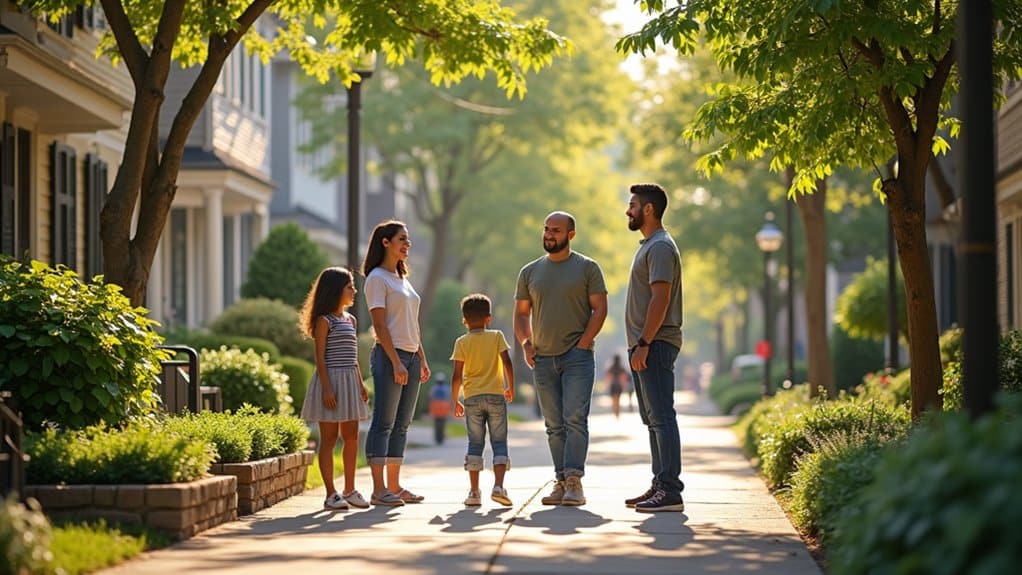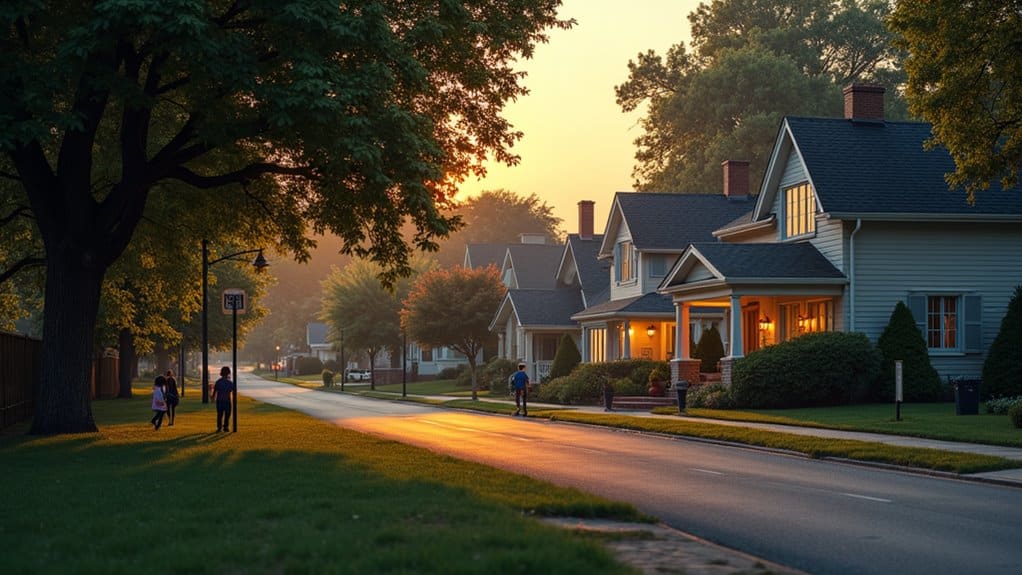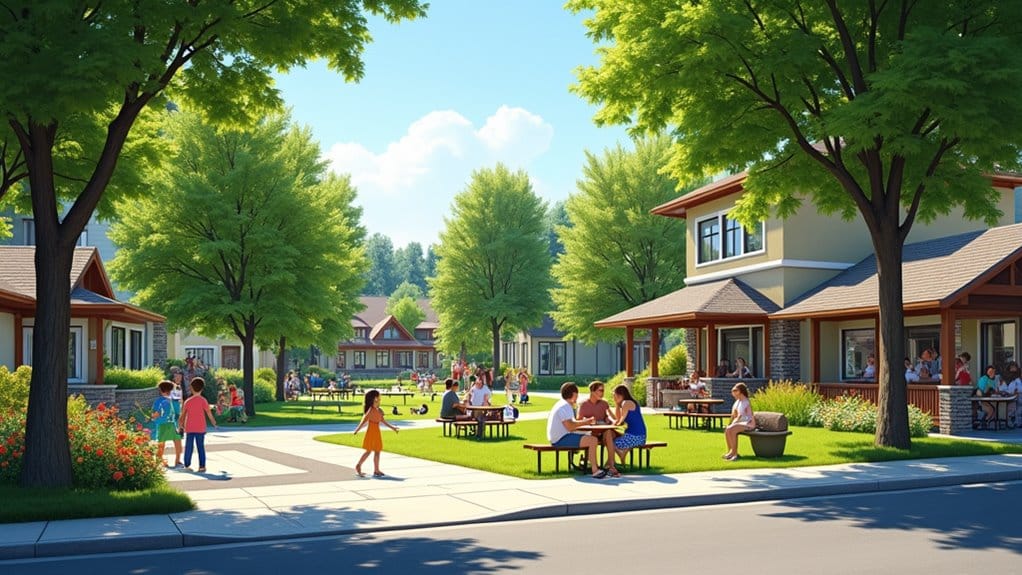
Expert Advice on Moving to a New Neighborhood
When moving to a new neighbourhood, start by assessing important factors like safety, school quality, and local amenities. Look into crime statistics and school ratings to ensure a safe, family-friendly area. Being close to work and shops can save you time and help you settle in quicker. Also, consider any future development plans that could increase your property's value.
Once you've moved in, unpack methodically and make an effort to introduce yourself to your neighbours. Attend local events to help you integrate and feel part of the community. These strategies can make your transition smoother and enhance your experience in your new home.
Key Takeaways
- Research the area's diversity, job market, quality of schools, and safety ratings to ensure it's a good fit for you.
- Check crime statistics and community initiatives to assess safety and local engagement.
- Review housing market trends and budget for moving expenses, utilities, and any unexpected costs to stay financially secure.
- Prioritise unpacking essentials and tackle one room at a time to make your new home comfortable and organised.
- Introduce yourself to neighbours and take part in local events to build connections and settle into the community.
Criteria for Selecting a Neighborhood
When considering a move, choosing the right neighbourhood is crucial for your happiness and lifestyle. Start by looking at the diversity of the area; a mix of cultures can enrich your community experience. Additionally, consider that neighborhoods with a strong job market often have better resources for residents.
Check for schools—good or fair-quality options are important for your family's future.
Next, evaluate local employment opportunities. A neighbourhood with a strong job market can provide stability and growth. Additionally, consider neighborhoods that have been identified as high potential neighborhoods, as they often have developing assets and community cohesion.
Safety is also key; low crime rates and high safety ratings indicate a secure environment.
Consider future development plans as well. Areas being revitalised may see increased property values and better amenities in the future. A neighborhood's development potential can significantly influence its desirability and investment value.
Walkability and access to public transport can significantly ease your daily commute.
Lastly, take note of the neighbourhood's cleanliness and maintenance. Engaging with potential neighbours can offer valuable insights into community dynamics.
Importance of Proximity to Amenities
When selecting a new neighbourhood, consider your proximity to work and schools. Having both nearby can save you time and ease daily stress. Additionally, being close to local shops simplifies errands, ultimately improving your quality of life. For instance, a quick walk to the supermarket means less hassle on busy weekdays. Moreover, living near parks and green spaces can enhance outdoor recreation opportunities and contribute to a more relaxed lifestyle. Furthermore, choosing a location that allows for lower moving costs can make the transition to your new home more affordable.
Work and School Access
Finding a neighbourhood that provides easy access to both work and school can significantly improve your family's quality of life. A shorter school commute allows your children to spend more time at home, engaging in activities that promote their development. Living near schools not only enhances safety but also encourages independence, enabling kids to walk to school and manage their time effectively. This proximity can also reduce risks from dangerous roads, fostering a safer environment for your children. Additionally, being close to schools allows for easier packing strategy during transitions, as you can quickly access necessary supplies.
Here's a quick look at the benefits of living close to work and school:
| Aspect | Benefits |
|---|---|
| Time Efficiency | Less travel time means more family time. |
| Child Development | Fosters independence and responsibility. |
| Parental Involvement | Makes it easier to attend school events and volunteer. |
| Community Building | Strengthens neighbourhood connections and social ties. |
Choosing the right location can make a real difference in your family's daily life.
Local Shopping Convenience
Living in a neighbourhood with convenient shopping options can significantly improve your daily life. Having amenities like supermarkets and local shops nearby shapes your routine and enhances convenience.
Picture this: fresh fruit, everyday essentials, and ready meals just a short stroll away. Recent shopping trends show that corner shops are transforming into community hubs, thriving in densely populated areas along major roads. These local shopping options not only save time but also strengthen community ties. Neighbourhoods with easy access to shops encourage more interactions among residents, enriching local dynamics. Furthermore, the extended hours of these stores ensure that you can meet your shopping needs at any time, making them an invaluable resource for busy lifestyles.
Additionally, local businesses boost the economy by employing local residents and reinvesting in the community.
Evaluating Safety and Crime Rates

When considering a new neighbourhood, checking local crime statistics is vital for your safety.
Look into existing safety measures and engage with community initiatives to help create a secure environment. For example, local neighbourhood watch schemes can be very effective. Adequate street lighting reduces crime opportunities and enhances overall safety. Understanding these factors will aid you in making an informed choice about your potential new home.
Research Local Crime Statistics
When choosing a new neighbourhood, it's crucial to research local crime statistics. Start with reliable sources like the Office for National Statistics or local police force websites, which provide comprehensive crime data.
Focus on key indicators such as overall crime rates, violent crime, and property crime, comparing these figures to national averages.
Look at crime trends over the past five years to assess potential future risks. Tools like local crime maps can help you pinpoint areas with higher crime rates. Understanding these patterns will give you a clearer picture of safety.
Also, check for local crime prevention initiatives and neighbourhood watch schemes. Being aware of community efforts to tackle crime can offer added reassurance.
Engaging with local police can provide further insights into specific issues in the area. By gathering this information, you'll be better equipped to make an informed decision about your new home, ensuring it meets your safety expectations and lifestyle needs.
Neighborhood Safety Measures
Safety is a top priority when choosing a new neighbourhood. When assessing safety measures, consider the design of the area. Well-lit streets and well-maintained pavements can deter crime and boost your sense of security.
Ensure there's sufficient street lighting, as it's crucial for keeping residents safe after dark. Proximity to emergency services, such as police and fire stations, is also vital. The closer you're to these facilities, the quicker help can arrive in an emergency.
Reliable public transport not only enhances safety but also makes it easier to navigate the area. Incorporating safety technologies can provide additional peace of mind. For instance, installing motion-sensor lights at home or using timers for your lights when you're out can create the illusion of being at home.
Joining a neighbourhood watch scheme can also encourage community vigilance. Don't forget to check crime maps to get a clearer picture of any issues in the area. Trust your instincts about how safe the neighbourhood feels after your evaluation.
Community Engagement Initiatives
Engaging with your new community enhances your sense of belonging and helps you assess safety and crime rates. By attending community workshops, you can learn about local crime data and work alongside fellow residents to evaluate neighbourhood safety effectively. Gathering crime statistics from local police and using online tools can help identify areas needing attention.
Collaboration among residents is crucial for understanding the specific safety issues in your area. Community insights can highlight concerns that statistics might miss. Joining initiatives like Neighbours In Action (NIA) enables you to take meaningful steps towards improving your neighbourhood.
Activities such as Photovoice allow residents to document key areas, paving the way for design workshops focused on safety issues. Regular safety audits led by community members can prioritise improvement efforts, fostering a sense of collective purpose and community pride.
Assessing Local School Quality
When considering a move to a new neighbourhood, evaluating local school quality is essential as it significantly influences your child's education and future prospects.
Begin by looking at school rankings for a general idea of academic performance. However, don't rely solely on these figures; delve deeper into the assessment methods used by the schools.
Seek out schools that use high-quality assessments aligned with national curriculum standards and that focus on essential skills. Check that their standardized test scores are valid, reliable, and unbiased, effectively measuring higher-order thinking skills.
A good school should also foster deeper learning and develop 21st-century skills through its curriculum and teaching approaches.
Assessments shouldn't only gauge student performance but also offer constructive feedback to aid teaching.
Investigate whether the school actively involves parents and the community, providing clear data on student learning and progress. This engagement can be crucial in helping you make well-informed decisions regarding your child's education.
Understanding Community Amenities

When relocating to a new neighbourhood, it's crucial to understand the community amenities available.
Look for facilities such as swimming pools, gyms, and parks that align with your interests and requirements. A lively community with local services can enhance your living experience and help you connect with your neighbours.
For instance, a nearby café or a local market can be great for socialising and enjoying your new surroundings.
Types of Community Amenities
Choosing the right community amenities can significantly enhance your living experience. When planning a move, consider which features will best improve your daily life. Various community amenities cater to different needs, ensuring you'll find something that suits you.
Here are some key types of community amenities to consider:
- Recreational facilities like local parks and outdoor spaces for relaxation.
- Family amenities such as playgrounds and children's clubs to keep kids entertained.
- Fitness options including gyms, swimming pools, and sports courts for those with active lifestyles.
- Educational resources like libraries and well-regarded schools that support learning.
- Convenience stores and coffee shops for easy access to everyday essentials.
These amenities not only promote health and wellness but also encourage community interaction, helping you connect with neighbours.
By prioritising these features, you can create a living environment that aligns with your lifestyle and goals.
Take the time to explore your new neighbourhood and its offerings—you'll appreciate the benefits!
Importance of Local Services
Local services are crucial for enhancing the quality of life in any neighbourhood. When choosing a community, consider how local businesses and amenities can improve your daily experience.
Independent shops and services keep money within the local economy, creating jobs and supporting community development. This entrepreneurial spirit not only bolsters economic stability but also encourages community involvement, fostering a lively social atmosphere.
Access to essential services such as schools, parks, and gyms greatly affects your well-being. These facilities offer recreational and educational opportunities that bring people together.
Furthermore, robust local services build trust and cooperation among residents, which can enhance neighbourhood safety and property values.
When assessing a neighbourhood, take note of its local businesses and community dynamics. A thriving local economy often signals a supportive environment where residents care about each other's success.
Budgeting for Your New Home
Budgeting for your new home is crucial for a smooth transition and financial stability. To manage your moving costs effectively, consider the following initial and ongoing expenses:
- Moving services and packing materials: Account for these significant upfront costs.
- Furniture and appliances: Don't forget to budget for essential items for your new space, like a fridge or sofa.
- Utility deposits and setup fees: These are often overlooked but necessary for getting your new home up and running.
- Temporary storage costs: If there's a gap between moving out and moving in, consider storage options.
- Cleaning expenses: Remember to factor in cleaning costs for both your old and new homes.
For ongoing costs, ensure your mortgage payments don't exceed 28% of your gross monthly income.
Include property taxes, home insurance, and any service charges. Regular maintenance, utility bills, and unexpected expenses should also be part of your budget.
Conducting Pre-Move Research

Moving to a new neighbourhood can be daunting, but thorough pre-move research can make the transition easier. By exploring the local culture, you'll find it easier to settle in and feel at home. Look into the local cuisine and community events to discover what makes your new area special.
Here's a quick reference table to help you organise your research:
| Research Area | Key Points |
|---|---|
| Local Culture | Investigate traditions, social norms, and local history |
| Community Events | Attend local festivals and activities for insight |
| Neighbourhood Safety | Check crime rates and school quality |
| Housing Options | Research property prices, rental rates, and amenities |
| Local Resources | Talk to residents and review local services |
Utilising online forums and local publications can keep you updated on community matters and opportunities. By prioritising your pre-move research, you'll not only find a suitable place to live but also embrace the vibrant life your new neighbourhood offers. Investing time in this process leads to a smoother transition and a more rewarding experience in your new community.
Visiting the Neighborhood
Exploring your new neighbourhood on foot is essential for getting to know its unique character.
Walking allows you to experience the area firsthand and encourages genuine local interactions that driving simply can't provide.
Here are some benefits of strolling through your new surroundings:
- Discover Hidden Gems: You might find parks, pathways, and local attractions that are easily missed from a car.
- Meet Neighbours: A friendly greeting can lead to conversations, helping you build connections and feel more at home.
- Get to Know Amenities: Spot nearby shops, cafes, and services that fit your lifestyle.
- Establish Routines: Regular walks can help you develop habits that make the neighbourhood feel familiar.
- Engage with Community Events: Staying active in your area lets you learn about local events you can attend to meet more people.
Walking is a simple yet effective way to immerse yourself in your new community.
Analyzing Local Statistics

When moving to a new neighbourhood, understanding local statistics is crucial for making informed choices.
It's important to examine crime rates and demographic trends to assess safety and community dynamics.
For instance, if you're considering a move to a particular area, look at the local crime data to see how it compares with other regions.
Tools like ArcGIS Pro and R can assist you in gathering and interpreting this data effectively, making the process simpler and more insightful.
Crime Rate Overview
Understanding the crime rate in a new area is crucial for making informed decisions about where to live or invest.
Here are some key points to consider:
- Use the UK Home Office's crime statistics for reliable national data.
- Check websites like Police.uk for detailed local crime reports.
- Look at historical crime data to identify trends over time.
- Speak to local police for insights into crime prevention measures.
- Explore neighbourhood watch schemes, which can significantly improve community safety.
Demographic Trends Analysis
Analysing local demographic trends is crucial for anyone thinking of moving to a new neighbourhood. Understanding these shifts helps you assess community diversity, which can significantly affect your living experience.
For example, high homeownership rates often indicate a stable environment, while an ageing population may point to changes in housing dynamics. Current demographic data can help you forecast future trends, such as whether families are likely to move in or out.
A rise in higher-socioeconomic status (SES) residents could suggest improved local services and amenities. On the other hand, if lower-SES residents are leaving, it might indicate economic difficulties in the area.
Examining income levels can also highlight potential concerns, such as deferred maintenance of housing, which could impact your living conditions.
Navigating Transportation Options
Exploring transport options in your new neighbourhood can significantly influence your daily routine.
Familiarising yourself with the local public transport systems and infrastructure can greatly improve your commuting experience. Here are some key points to consider:
- Public Transport Access: Determine if your area offers reliable options like buses or the Tube.
- Innovations in Transport: Keep an eye out for new developments, such as flexible bus services or expanded cycle lanes.
- Safety and Accessibility: Research recent upgrades that enhance safety for cyclists and pedestrians.
- Frequency of Services: Utilise online resources to check how often public transport operates and the areas it covers.
- Connectivity: Evaluate how well different parts of the neighbourhood are linked by public transport options.
Post-Move Unpacking Strategies

Once you've settled into your new neighbourhood and familiarised yourself with local transport options, it's time to tackle unpacking. Here are some straightforward tips to help you organise your new home efficiently.
Start by prioritising boxes by room and unpack essentials like toiletries and a change of clothes immediately.
Before you begin, ensure your space is thoroughly cleaned. Clearly label each box with its contents and the room it belongs to, and consider creating an inventory to keep track of everything.
Adopt a room-by-room approach, starting with high-traffic areas such as the kitchen, bedroom, and bathroom. Set up a designated area for boxes that are waiting to be unpacked to reduce clutter.
As you unpack, declutter along the way. Break down boxes as you empty them and have a system in place for recycling or donating items you no longer need.
Create an unpacking checklist and set mini-goals to maintain your motivation. Clean as you go to keep your space tidy.
If the process feels overwhelming, don't hesitate to seek professional help to speed things up. With these strategies, you'll feel at home in no time!
Building Relationships With Neighbors
Building relationships with your neighbours in a new area is vital for creating a friendly and supportive community. Strong connections can enhance your living experience and help prevent conflicts. Engaging in local events and gatherings can significantly improve your interactions.
Here are some practical strategies for forging those relationships:
- Introduce Yourself: A simple, friendly introduction can make a great first impression.
- Be Respectful: Acknowledge boundaries and privacy to build trust.
- Communicate Openly: Clear communication helps resolve issues calmly and effectively.
- Participate in Community Events: Join local gatherings to meet people and strengthen bonds.
- Offer Help: Lend a hand to neighbours when they need assistance, whether it's carrying groceries or helping with a DIY project.
Taking these steps creates a supportive atmosphere and encourages harmony. Engaging in one-on-one conversations and being active in community activities will help you establish lasting connections.
A strong neighbourhood network can offer security and companionship, so seize the opportunity to connect and you'll soon feel at home in your new community.
Adapting to Local Culture

Adapting to a new culture can be daunting, but it's vital for settling into your new area. Start by immersing yourself in local life; explore neighbourhoods and markets. This hands-on approach allows you to observe everyday routines and gain insight into local customs and etiquette.
Don't hesitate to sample local dishes at restaurants and street food stalls; it's a tasty way to connect with your community. Participate in festivals and cultural events to meet locals and experience the heart of the community, which can help ease any culture shock you might face.
Consider learning the language through classes or apps. This will improve your interactions and show respect for local traditions. Joining clubs or expat groups can also provide support and help you engage more with your new surroundings.
Planning for Long-Term Satisfaction
Building connections in your new neighbourhood is just the start; you'll also want to think about planning for long-term satisfaction.
Achieving lasting contentment involves considering various factors in your community that contribute to a fulfilling lifestyle. Here are five key points to keep in mind:
- Green Spaces: Look for local parks and gardens that provide opportunities for recreation and relaxation, such as a weekend picnic or a morning jog.
- Access to Amenities: Ensure essential services like supermarkets and healthcare facilities are within easy reach for convenience.
- Community Interaction: Get to know your neighbours through local events or casual chats, which can help you build a supportive network.
- Aesthetic Quality: Consider the neighbourhood's visual appeal—well-kept streets and attractive architecture can enhance your pride in where you live.
- Safety and Security: Choose areas that are perceived as safe to improve your overall sense of well-being.
Frequently Asked Questions
How Do I Handle Moving With Pets to a New Neighborhood?
To manage moving with pets, start by researching pet-friendly amenities in your new neighbourhood. Keeping to familiar routines can help your pets adjust, so stick to their usual feeding and walking times while you explore the area together. This consistency will provide them with comfort during the transition.
What Should I Know About Local Zoning Laws and Regulations?
Did you know that around 70% of land in the UK is governed by zoning regulations? Understanding local planning laws, including planning permissions and property restrictions, is crucial for making informed choices about land use and development. For instance, if you're considering converting a residential property into a business, you need to check if such a change is permitted in your area. Being aware of these regulations can save you time, money, and potential legal issues.
Are There Local Events or Festivals I Should Attend?
You should definitely look out for local community events and seasonal festivals. They're excellent for meeting new people, experiencing local culture, and supporting small businesses. Events like farmers' markets, Christmas fairs, and summer carnivals are not to be missed for the fun and connections they provide!
How Can I Find Local Volunteer Opportunities?
You can find local volunteer opportunities by visiting community centres and charities. They often have listings of available roles and projects. For instance, local food banks or animal shelters frequently seek volunteers. Getting involved not only allows you to make a difference but also helps you connect with others in your community.
What Is the Neighborhood's Policy on Noise and Disturbances?
Familiarise yourself with the neighbourhood's noise complaints policy. Knowing how to resolve disturbances—such as speaking directly with the person involved or understanding local regulations—ensures a peaceful environment and helps in addressing any issues effectively. For example, if a neighbour is playing loud music late at night, a polite conversation might resolve the matter more amicably than escalating it to the authorities.
Conclusion
Moving to a new neighbourhood can be a fulfilling experience if you choose wisely. Research shows that many people feel happier in their homes when they live near parks and recreational areas. By considering your proximity to local amenities, assessing safety, and getting to know the community, you can enhance your long-term satisfaction.
Building relationships with your neighbours and embracing the local culture can truly transform a house into a home. So, take the plunge and enjoy your new surroundings!


